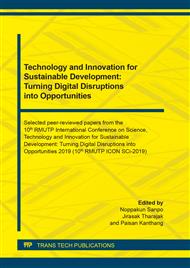[1]
N. Ozdil and S. Anand, Recent developments in textile materials and products used for activewear and sportswear. Electron. J. Text. Technol. 8(3) (2014), 68-83.
Google Scholar
[2]
S. Jose, Sports and Fitness Clothing: A Global Strategic Business Report. Prweb. February 8 (2011).
Google Scholar
[3]
The Global Industry Analysts, Inc., Encouraging Participation in Sports and Growing Penchant for Fitness Drive Demand for Sports and Fitness Clothing, The Global Industry Analysts, Inc., US, (2017).
Google Scholar
[4]
R. Shishoo, Textiles in Sport, Woodhead Publishing, Cambridge, (2005).
Google Scholar
[5]
J. Li, Y. Lu, F. Wang, Y. Sun, Z. Wang and M. Zhu, Development and performance evaluation of sportswear based on male body sweating pattern. J. Text. Res. 37(1) (2016) 116-122.
Google Scholar
[6]
M. Sampath, S. Mani and G. Nalankilli, Effect of filament fineness on comfort characteristics of moisture management finished polyester knitted fabrics. J. Ind. Text. 41(2) (2011) 160-173.
DOI: 10.1177/1528083711400774
Google Scholar
[7]
J. Dargahi and S. Najarian, Human tactile perception as a standard for artificial tactile sensing – a review. Int. J. Med. Robot. Comp. Assist. Surg. 1(1) (2004) 23-35.
DOI: 10.1002/rcs.3
Google Scholar
[8]
A. Ali, A. Sheraz, R. Abher, A. Faheem, I. Fatima and N. Yasir, Influence of fabric parameters on thermal comfort performance of double layer knitted interlock fabrics, AUTEX Res. J. 17(1) (2017) 20-26.
DOI: 10.1515/aut-2015-0037
Google Scholar
[9]
S.K. Chinta and P.D. Gujar, Significance of moisture management for high performance textile fabrics, Int. J. Inno. Res. Sci. Eng. Technol. 2(3) (2013) 814-819.
Google Scholar
[10]
B. Das, A. Das, V. Kothari, R. Fanguiero and M. Araújo, Moisture transmission through textiles Part I: processes involved in moisture transmission and the factors at play. AUTEX Res. J. 7(2) (2007) 100-110.
Google Scholar
[11]
N. Ozdil, A. Marmarah and S.D. Kretzschmar, Effect of yarn properties on thermal comfort of knitted fabrics. Int. J. Therm. Sci. 46 (2007) 1318–1322.
DOI: 10.1016/j.ijthermalsci.2006.12.002
Google Scholar


